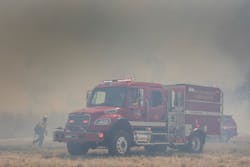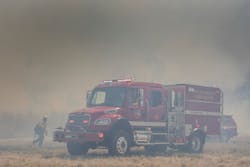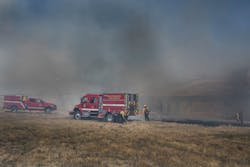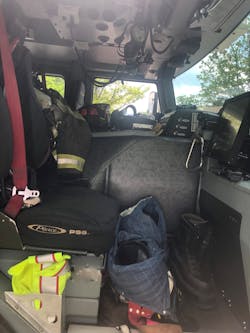Many agencies still have all their PPE and SCBA in the cab. Their reasons for not moving them out of the cab ranged from perceived potential delays with response on-scene time, and “that’s the way we have always done it,” to limited finances and resources for smaller departments, and the operational culture. On the other hand, many agencies have removed all the PPE and SCBA out of the cab and into separate compartments. The various agencies that chose to remove these items report the 15 to 20 seconds does not alter on-scene time. This also allows the crew to get out safely, exit the vehicle without the extra weight, don their gear while allowing everyone on that rig to collectively strategize at the same time. This also helps to prevent ankle, knee and back injuries ultimately lowering on-the-job injuries and injury rehab time.
Back in-service times
Deconning on scene and after a fire has turned into another challenge. Based on the data I’ve seen and collected, it takes the crew at least twice as long to return back to service after the deconning and bagging of their gear, replacing the gear, and SCBA cleaning — including replacing the straps, cleaning the bottles, pack frames, masks, tools, hose and more.
During my research, I reached out to many departments looking for average “back in-service” times after firefighting contamination exposure with gross decontamination on scene.
Below is the generally accepted process:
- Contaminated firefighters perform gross decontamination on scene prior to removal of their SCBA and facepiece. Firefighters will clean and rinse off exposed protective clothing with the scrub brush and soapy water. Helmet, facepiece, coat, pants, boots, gloves, SCBA and exposed equipment will be cleaned.
- At the completion of fireground activities, firefighters will bag and zip-tie closed all contaminated PPE prior to returning to quarters. Transport of exposed PPE, tools and hoses back to quarters should be by utility vehicle or on tailboards, walkthrough or hosebed, if it can be properly secured. The crew compartment should be avoided.
- Crews that have contaminated gear will remain out of service until their second set of gear is placed in-service on the apparatus.
- Members will then shower.
- o Recommended shower process consists of a thorough rinse, soap-up from head to toe, rinse and repeat two times.
- o Units can then be placed in service.
While the focus on the Clean Cab Concept is with the PPE and SCBA being carried in the cab with the firefighters, many agencies, including Los Angeles City and Los Angeles County, have been storing the SCBA in separate compartments outside of the cab for many years. Some departments have gone as far as having color-coded tools and equipment, which now means one color for any firefighting activities and the other color for non-fire calls and activities. Because of the growth in population, congestion, and narrower streets that most departments are experiencing, many agencies are moving to make their fire trucks shorter and smaller. This creates a challenge to find separate compartments for SCBA, PPE, additional tools and equipment. This causes a domino effect of building more compartments while attempting to reduce the footprint of the truck.
Structural vs. wildland
One area of firefighting that has been over-looked are the wildland firefighters. Obviously, there is smoke where wildland firefighters work. Curiously, few studies and literature quantify the effects on the health of these firefighters. One study, published in 2017, provides a preliminary analysis addressing the wildland smoke and the effects on the wildland firefighter. It is titled Wildland Fire Smoke Health Effects on Wildland Firefighters and the Public — Final Report to the Joint Fire Science Program.Another reference is the NIOSH Study in 1988 regarding the Yellowstone Fire. Listed are the particles the firefighters breathed in, captured on their gear, and introduced into the wildland vehicle. These include:
- Aldehydes (volatile organic compounds)
- Sulfur dioxide (SO2)
- Carbon monoxide (CO)
- Particulate matter
- Acrolein
- Benzene
- Crystalline silica (OSHA classified carcinogen)
- Intermediate chemicals
- Diesel exhaust (Group 1 carcinogen)
Don’t forget about the fire retardant dropped by the tankers, which is also a type of carcinogen.
Knowing this, my hope is that we begin to take a broader look at the wildland side and then make the steps toward a “Cleaner, Healthier Cab and PPE” concept for the wildland firefighter, the apparatus and equipment essential to do their job.
EMS exposure
When a crew responds in an engine or aerial to an EMS call that includes the patient’s blood, body fluids, urine, and more, what happens to the crew’s gear afterward? According to two experienced firefighters I talked to, it goes right back in the cab. Is it deconned after the call? Rarely! Then on the way back from the call the crew decides to stop at the store to pick up dinner. The grocery bags then go in the cab — possibly on the gear, but a lot of times on the floor between the rear jump seats. Then the crew returns to the station and the grocery bags are carried out of the cab of the truck and into the kitchen or day room at the firehouse, then placed on the counter or maybe the dining room table. Is this scenario the same for the ambulance/medic?This is a very contaminated picture of gear, cabs, and living area; and we let the preschool or kindergarten classes tour the station and climb in and out of the engines, aerials and ambulance! We also let parents and kids “play” with the bunker gear and take photos while standing in bunker pants, suspenders, coats, helmets, and holding the tools — axe and halogen mostly. I am guilty of doing this with my own kids and grandkids.
Diesel exhaust
In my previous article, “Fire Apparatus & Cancer Prevention” found at Firehouse.com/21028263, I mention diesel exhaust contamination inside and outside the station, stating, “Apparatus vehicle exhaust, mainly diesel exhaust, is a carcinogen that could affect firefighter health, and efforts should be made to minimize exposure at all times.” Now with the Clean Cab Concept this also includes the PPE storage in the station and deconning on scene.
- All PPE on storage racks that have the potential to be exposed to exhaust contaminants should be protected by closing and zipping bunker coats and pants to prevent particulates from landing on and absorbing into the liners or stored in a separate room. However, when consulting with other departments, I still see exposed bunker gear hanging in gear lockers in the apparatus bays — unprotected.
- All crews and personnel should utilize the station exhaust systems and never let any apparatus/equipment run within the bays unless absolutely necessary. In the unlikely event that need arises, the exhaust system hose shall always be in place and the apparatus shall not exceed idle speed. While I understand the finance and remodel effort it takes to have a diesel exhaust removal system put in a fire station, it is unbelievable to see a new station without it. Recently, a department in Florida did not see the need to install an exhaust removal system. Nor did they see the need to retrofit the trucks with filters to capture diesel exhaust while in or out of the station. The agency’s “fix” was to wall mount large vents and fans on each end of the apparatus bay “up high” to bring in fresh air and exhaust the diesel fumes.
- When possible, apparatus that can be shut down, should be shut down during any incident to further limit exposure to contaminants. Close windows and recirculate air instead of utilizing fresh air inlets for air conditioning and heating to reduce smoke and contaminants from entering the crew cabs. Safety shall never be leveraged to meet this objective.
- Plastic seat covers have been provided for all apparatus and shall be placed over all seats for the return trip to the fire station to prevent any contamination to the apparatus cab seats.
- No exhaust from any vehicle, gas or diesel, should expose bunker pants that are stored on the bay floor, most specifically the groin area of bunker pants and hoods typically placed on top of pants for call readiness. When possible, store gear within the apparatus to prevent contamination by exhaust.
As Chief Alan Brunacini once said, “Two things firefighters hate; the way things are now and change.” Get ready for change! While 100 percent mediation is not possible in avoiding all carcinogens, when implemented correctly, a cleaner, healthier cab will help minimize the exposure with cross-contamination in the cab, the firehouse, your personal vehicle and your home. We must define a cultural strategy to prevent carcinogenic contaminant in the cab, thus reducing job-related illness and living healthier lives. What this really means is I can do it better for me, so we can take care of each other and better care of them — the citizens and community we serve.
Brian Brown
Brian Brown, a consultant with Craven and Associates, is the retired bureau chief, fleet services for South Metro Fire Rescue in Colorado, with more than 30 years fire/apparatus experience. Brown is a member of the Firehouse editorial board.









